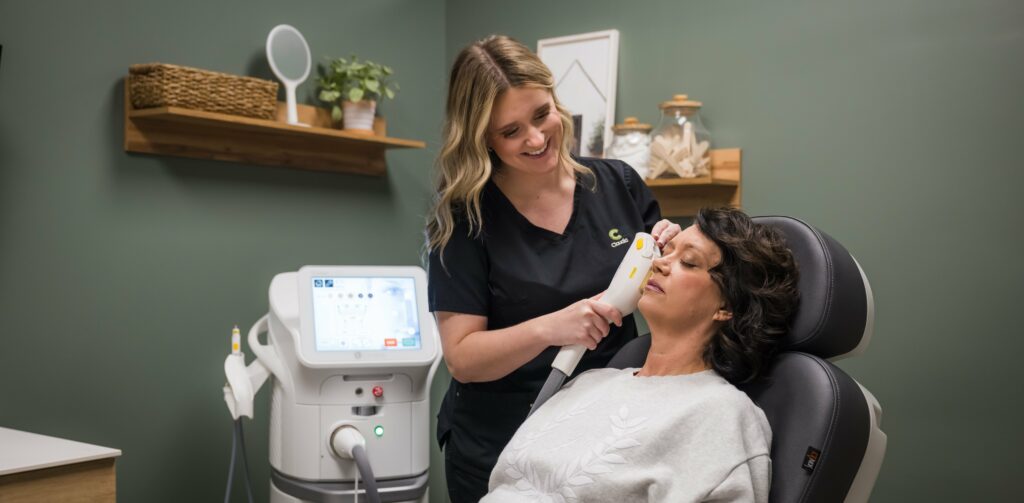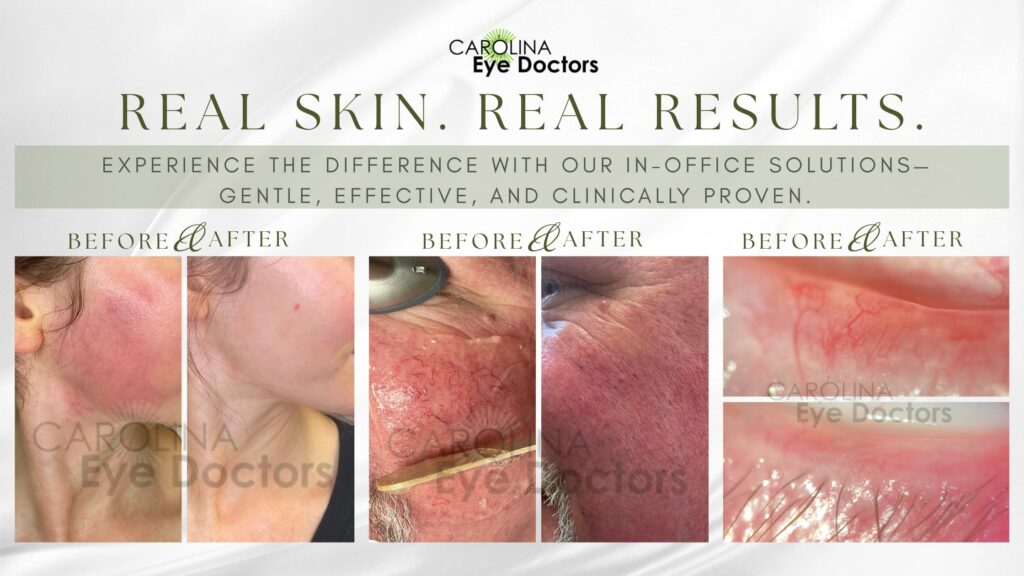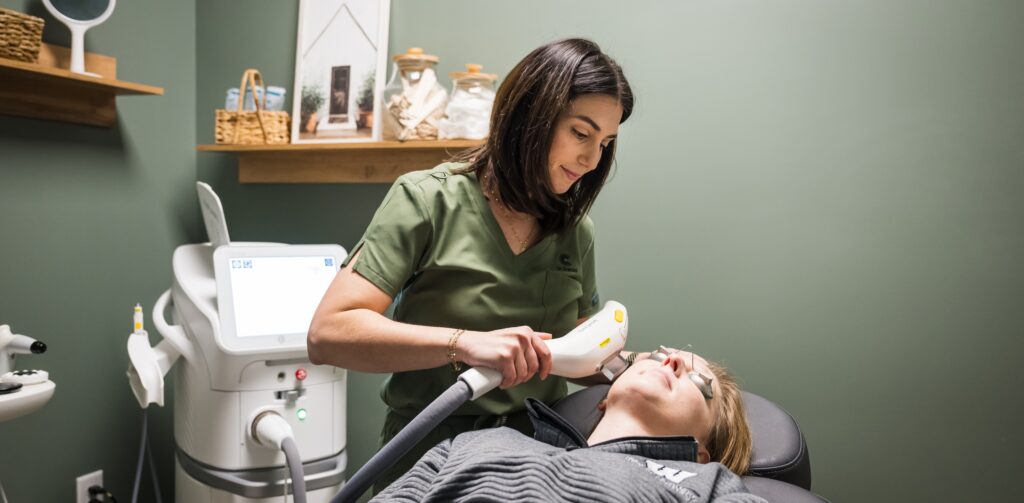April is Rosacea Awareness Month, and while most people think of rosacea as a skin issue—redness, bumps, and visible blood vessels on the cheeks, nose, or forehead—it’s actually more than just skin deep. While it’s often managed by dermatologists, many people are surprised to learn that rosacea can affect the eyes too, and in many cases, those eye symptoms show up before any skin changes do.
That’s where we come in. As eye doctors, we’re often on the front lines of diagnosing and managing rosacea—especially when it affects the eyes. While many people are familiar with the classic facial symptoms, rosacea actually comes in four subtypes:
- Erythematotelangiectatic rosacea (facial redness and visible blood vessels)
- Papulopustular rosacea (redness with acne-like bumps)
- Phymatous rosacea (thickened skin, often on the nose)
- Ocular rosacea, a chronic inflammatory condition that can lead to red, dry, irritated eyes, burning, and that gritty “something-in-your-eye” feeling.
What many don’t realize is just how often the eyes are involved. In fact, up to 75% of rosacea patients develop eye symptoms. It’s not unusual for the first signs of facial rosacea—frequently accompanied by ocular rosacea—to be identified during a comprehensive eye exam. This is largely because many individuals attribute facial redness to common factors such as sensitive skin, sun exposure, or stress, and may not recognize it as a medical concern. As a result, they often do not seek dermatologic evaluation right away. However, the eyes can reveal early signs of rosacea, making an eye exam a key opportunity for early detection and intervention.
Ocular Rosacea Causes and Triggers
The exact cause of ocular rosacea, much like its skin counterpart, remains unclear—but it’s believed to be influenced by a combination of factors. These may include genetics, environmental triggers, bacterial involvement, and even the presence of tiny eyelash mites called Demodex.
In addition to underlying causes, there are several known triggers that can worsen ocular rosacea, many of which also aggravate skin symptoms. These include:
- Spicy foods
- Alcohol
- Sun exposure
- Wind
- Extreme temperatures
- Emotional stress
- Intense physical activity
- Heat from hot baths or saunas
Identifying and avoiding these triggers can play a key role in keeping symptoms under control.
Why Rosacea Can Lead to Styes, Chalazia, and Lasting Eye Inflammation
Although rosacea is considered a benign inflammatory skin condition, its effects on the eyes can be far from harmless. Over 80% of rosacea patients develop meibomian gland dysfunction (MGD), where the tiny oil glands in the eyelids become clogged or inflamed. These glands are essential for healthy tears, and when they stop working properly, it can lead to chronic dry eye, irritation, and even permanent gland damage.
This is also why many patients with ocular rosacea experience recurring styes or chalazia, which can be painful and frustrating. Over time, if left untreated, this chronic inflammation can reduce tear quality and essential nutrients, causing damage to the surface of the eye—which is why early diagnosis and treatment are so important.
How to Manage Ocular Rosacea: From Lid Hygiene to IPL Therapy

Both rosacea and ocular rosacea can feel incredibly frustrating, even defeating conditions—especially when mild or over-the-counter treatments don’t seem to make a difference. Many patients try eye drops or topical creams with little relief, which often leads to the question: Why isn’t this working? The answer lies in the nature of rosacea itself. This is not just a surface-level issue—it’s a chronic inflammatory condition affecting the skin and meibomian glands in the eyelids.
While there’s currently no cure for ocular rosacea, the good news is that there are highly effective ways to manage it. The most successful treatment approaches go beyond simply soothing symptoms—they focus on treating the root cause. Effective care requires a comprehensive, multi-faceted approach.
Daily eyelid hygiene is a critical foundation, using warm compresses and gentle cleansing to keep the oil glands clear and functioning. Lifestyle changes, such as managing environmental triggers (like sun, wind, or temperature changes), reducing stress, and avoiding spicy foods or alcohol, can also help minimize flare-ups.
Nutritional support, particularly with omega-3 fatty acid supplements, has been shown to improve meibomian gland function and promote healthy tear production from within.
While daily care and lifestyle changes are essential, many patients—regardless of symptom severity—can benefit from advanced in-office treatments like OptiLight IPL. This innovative therapy enhances results by targeting the root cause of both ocular and facial rosacea.
OptiLight by Lumenis is a groundbreaking treatment that not only helps relieve dry eye symptoms but also addresses the underlying inflammation and abnormal blood vessels commonly seen in rosacea. Originally developed for dermatology, this FDA-approved Intense Pulsed Light therapy has been adapted for eye care to treat both the eyelids and surrounding facial skin.
OptiLight works by delivering gentle pulses of light that reduce inflammation, shrink dilated blood vessels, and restore healthy function to the meibomian glands, which are often blocked in rosacea patients. By improving oil flow in the tear film and calming facial redness, OptiLight offers a dual benefit: clearer, more comfortable eyes and a calmer complexion.

Taking the Next Step Toward Relief
Rosacea—especially when it affects the eyes—is more than just a cosmetic concern. It’s a chronic inflammatory condition that can affect your comfort, vision, and overall quality of life.
If you’re experiencing persistent facial redness, dry or watery eyes, burning, itching, or recurring styes, you could be one of the 16 million Americans living with rosacea—and you’re not alone.
The good news is that with the right diagnosis and a personalized treatment plan, rosacea can be managed effectively. At our office, we take a comprehensive approach to care—combining daily eyelid hygiene, nutritional support, lifestyle guidance, and advanced treatments like OptiLight IPL to target inflammation at its source.
You don’t have to live with the discomfort of rosacea. Whether it’s your eyes, your skin—or both—we’re here to help you take control and feel like yourself again. Schedule your appointment today and take the first step toward brighter, healthier skin and eyes.













